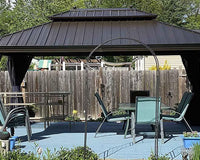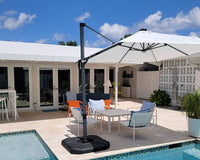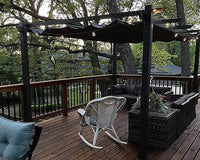Gazebos are a lovely addition to any yard, providing a cozy place to sit back and soak in the outdoors. But what happens when the wind starts howling? It's important to know if your hardtop gazebo can handle a strong breeze. Wind resistance is to make sure it stays a safe part of your outdoor space for years to come. Whether you're thinking of buying one or wondering about the one you've got, this article is going to explain how well these sturdy structures stand up to gusty weather. Read more about hardtop gazebos and see how they hold up when nature blows through.
Why Choose a Hardtop Gazebo?
Looking to pick out the perfect gazebo, you're probably now asking, why a hard top gazebo and not a soft top? Here is the scoop: hardtop gazebos are yet another strong, silent type. They are much stronger and can stand up to a lot, especially in windy weather conditions.
Hardtop gazebos are made with roofs made from strong and sturdy-as a rule, steel or aluminum-materials that have proved to be outstandingly hard. Unlike their soft-top cousins, featuring flimsy canopies-usually fabric that is subject to flapping and even tearing in a stiff breeze-hardtops are nice and solid. This makes them a really solid choice if you happen to live in a particularly wind-driven area. Moreover, these gazebos lend a touch of class and sturdiness to your outdoors as well. They are a long-lasting solution that can withstand not just the wind but the rain, snow, and harsh sun.

Wind Ratings for Gazebos
Think of wind ratings as a scale that measures how much of a punch your gazebo can take from the wind before it starts to struggle. For hardtop gazebos, these ratings are pretty impressive – many are built to stand firm in winds up to 100 miles per hour! That's stronger than the gusts in a lot of severe weather conditions.
Now, if you're eyeing a wooden hardtop gazebo, know that they're typically rated for winds around 50 mph. These beauties combine the rustic charm of wood with solid resilience against breezes. Then, there are the professional-grade canopy tents. Although not exactly gazebos, they're related and worth mentioning here because they're built like little fortresses, able to endure winds of up to 75 mph.
So why do these numbers matter? Well, they give you peace of mind. If the wind rating is high, you won't have to panic every time the weather report mentions a windy day. Instead, you can chill out under your gazebo's shelter, confident that it isn't going anywhere.
Key Ingredients for a Wind-Proof Gazebo
So, what goes into making a gazebo ready to face a blustery day? It's all about the materials and design.
Sturdy Frames
First up is the frame-the skeleton of your gazebo. You'll usually find these frames made from metals like steel or aluminum because they're both superheroes when it comes to strength and stability. Steel is the heavyweight champion, offering solid support. Aluminum, on the other hand, is lighter but still tough, and it has the added bonus of being rust-resistant, which is great for those rainy days.
Tough Tops
Next is the roof, which is like the shield for your gazebo. Often made from materials like polycarbonate panels or metal sheeting, these roofs are designed not just to resist the push and pull of the wind but also to keep you dry during a rainstorm. Polycarbonate is a particular favorite as it's strong yet lets some light through, giving you that sunny outdoor feeling without the sunburn.

Design Dynamics
The design of the gazebo is also key to fending off the wind. A sloped or peaked roof can help to redirect the wind over and around the structure, rather like water flowing around a rock in a stream. This not only prevents the wind from getting a good grip but also helps to reduce the pressure it places on the gazebo.
Solid Anchors
Finally, no matter how strongly constructed the gazebo may be, it needs to be securely fastened to the ground. That can entail bolting it to a concrete pad or fastening it down with heavy-duty stakes into the ground if it's on grass or dirt.Some people may wonder, "Can I install a hardtop gazebo on grass?" Find the answer on our blog titled "Can I Install A Hardtop Gazebo On Grass?".Think of those anchors this way: similar to tree roots in locking your gazebo in place to keep it upright and secure no matter what kind of wind tosses it about.
Proper Gazebo Installation
Wind won't be an issue if your gazebo is installed properly. Start by securing it firmly to the ground with anchors appropriate for your setting, like heavy-duty stakes for grass or strong fasteners for concrete and wood. This keeps your gazebo from taking off like a kite. Additionally, make everything level; an unbalanced gazebo is more prone to damage since wind pressure can hit unevenly.
If you're comfortable with tools and basic construction, you may be able to install the gazebo yourself. However, hiring a professional can guarantee a sturdy setup. Don't forget regular maintenance checks, especially after harsh weather-tighten loose bolts and replace parts as needed. A well-maintained gazebo is a long-lasting one. It will ensure a reliable and safe outdoor enjoyment space for years to come.

Choose the Perfect Spot: Gazebo Placement and Wind
The right location can transform your hardtop gazebo from a windy-day worry to a sheltered retreat you can enjoy, even when the leaves are rustling and the branches are swaying.
Your Yard's Wind Patterns
First up, you'll want to play detective with your yard's wind patterns. Notice where the wind usually comes from and which areas are most protected. Placing your gazebo behind a natural windbreak, like your house or a tall hedge, can make a huge difference. Just be sure not to tuck it too close to trees-the last thing you want is a branch coming down on your new hideaway.
Terrain Matters
The lie of the land matters, too. So, it will provide better wind resistance where a gentle slope may be compared to the spot at the top of a hill where the wind has free rein. And while talking about terrain, remember that water features can affect the wind. If you have a pond or stream, consider how the breeze interacts with the water before deciding on the perfect gazebo spot.
Local Climate Considerations
Now, not forgetting your local climate, if you live in an area prone to heavy gusts of wind, you will want to be very careful about placement. In places like near the sea or wide-open plains, anchoring the gazebo against the wind is not just highly recommended but a necessity.
Respecting Building Codes and Regulations
Before you break ground, it's also critical to check out your local building codes and homeowners' association regulations, if applicable. There may be specific rules about how and where you can build, especially when it comes to structures designed to face the elements. Staying on the right side of regulations can save you a heap of trouble (and money).
Accessibility and Use
Finally, think about how you'll use your gazebo. You'll likely want it close enough to the house for convenience but far enough away to feel like an escape. Consider the path to your gazebo as well-you want it to be easy to reach, even when the weather is less pleasant.
Add-Ons for Your Gazebo's Wind Resistance
To boost your gazebo's resistance to wind, consider adding wind panels that can easily attach to the sides. These panels, made from sturdy materials like polycarbonate or canvas, not only protect against breezes and add structural stability but also offer the versatility to change with your needs. Additionally, curtains and mosquito nets are more than just for show; they help block wind gusts and provide a cozy, insect-free zone.
For extra reinforcement in windy locales, anchor your gazebo with tension cables or straps-these act like support wires to bolster the structure. Portable gazebos can benefit from weighted feet filled with sand or water to prevent liftoff. And don't forget, regular maintenance is crucial; routinely tighten hardware and replace parts as needed to ensure all these wind-fighting features function at their best.
A Windproof Gazebo Haven
The hardtop gazebo is a robust retreat constructed to withstand the whims of nature. With its strong frame, tough roof, streamlined design, and sturdy anchoring, you will have a guarantee of a wind-resistant haven offering peace of mind and a reliable outdoor escape. Whether it's sipping your coffee on a breezy morning or entertaining guests while the wind whispers through the trees, there your gazebo stands, standing for the three things: thoughtful placement, durability, and the plain joys of outdoor living. Embrace that breeze, knowing your gazebo is designed not just for the gusts of today but also for the changing winds of tomorrow.





1 comment
Adam
Just got home from playing games at the inlaws.. Apparently my 12×12 all metal construction gazebo went flying. Damaged the house, and broke the privacy fence to keep the dog in.. Ugh!! Not these peopes fault, but I needed to vent some where! So frustrating :(